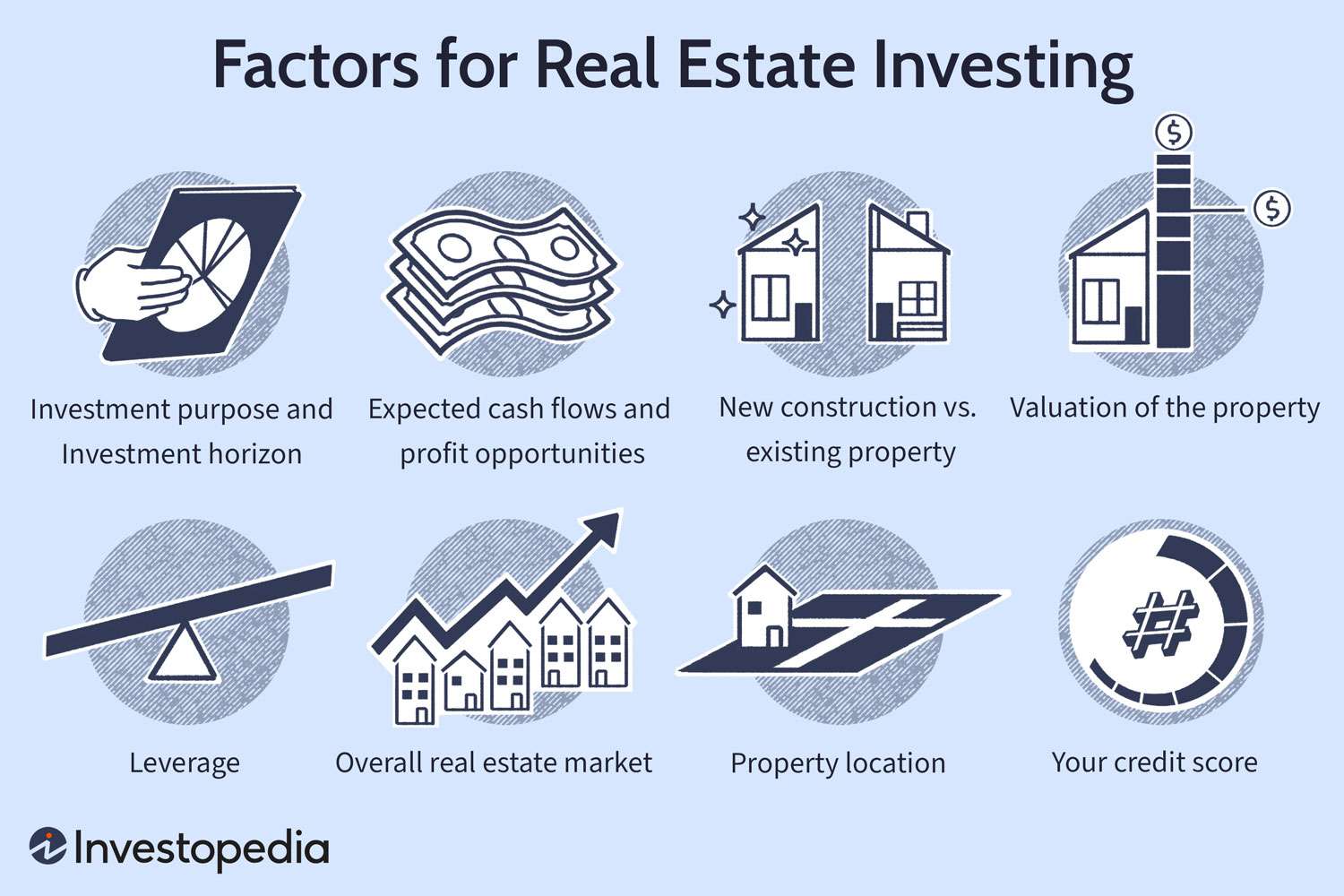Real Estate Investment: Building Wealth in a Tangible Asset
Introduction
Real estate has long been a cornerstone of wealth creation, offering investors a tangible asset with the potential for both income generation and capital appreciation. Unlike the often-abstract world of stocks and bonds, real estate provides a sense of stability and control, making it an attractive option for both seasoned investors and newcomers. In a dynamic economic landscape, understanding the nuances of real estate investment is crucial for capitalizing on its unique benefits. This article delves into the enduring appeal of real estate, explores various investment avenues, analyzes current market trends, and provides insights for building a robust and profitable real estate portfolio.
Why Invest in Real Estate?
Real estate offers several compelling advantages that make it a favored asset class for long-term wealth building:
Tangible Asset and Stability
Unlike stocks or cryptocurrencies, real estate is a physical asset that you can see, touch, and utilize. This tangibility often provides a sense of security and stability, especially during periods of market volatility. While property values can fluctuate, real estate generally tends to appreciate over the long term, acting as a hedge against inflation. The inherent utility of property, whether for residential, commercial, or industrial purposes, ensures a fundamental demand that underpins its value [1].
Income Generation
One of the most attractive aspects of real estate investment is its potential for consistent income generation through rental properties. Residential, commercial, and industrial properties can provide a steady stream of cash flow, which can be used to cover expenses, reinvest, or provide passive income. This income stream can be particularly appealing for those seeking financial independence or supplementing their retirement funds. The stability of rental income can also provide a cushion during economic downturns, making real estate a resilient investment [2].
Capital Appreciation
Beyond rental income, real estate offers the potential for significant capital appreciation. As property values increase over time, investors can realize substantial gains when they sell their assets. This appreciation is driven by various factors, including population growth, economic development, inflation, and scarcity of land. Strategic investments in growing areas or properties with potential for value-add improvements can further enhance capital appreciation [3].
Diversification
Real estate can serve as an excellent diversification tool within an investment portfolio. Its performance often has a low correlation with traditional assets like stocks and bonds, meaning it can help reduce overall portfolio risk and volatility. During periods when other asset classes may be underperforming, real estate can provide stability and alternative returns, contributing to a more balanced and resilient investment strategy [4].
Tax Advantages
Real estate investors can benefit from various tax advantages, including deductions for mortgage interest, property taxes, operating expenses, and depreciation. These deductions can significantly reduce taxable income, enhancing the overall profitability of real estate investments. Additionally, strategies like 1031 exchanges allow investors to defer capital gains taxes when reinvesting proceeds from the sale of one property into another, further optimizing returns [5].
Leverage
Real estate allows investors to use leverage (borrowed money) to control a larger asset with a smaller initial capital outlay. This means that a relatively small down payment can give an investor control over a much larger property, amplifying potential returns. While leverage also magnifies risk, when used prudently, it can significantly accelerate wealth accumulation in real estate [6].
Types of Real Estate Investments
Real estate investment is not a one-size-fits-all endeavor. There are various types of properties and investment strategies, each with its own risk-reward profile:
Residential Real Estate
This is perhaps the most common entry point for real estate investors, involving single-family homes, multi-family dwellings (duplexes, triplexes, apartment buildings), and condominiums. Residential properties typically generate income through rent and appreciate in value over time. The demand for housing is constant, making it a relatively stable investment, though it requires active management or the hiring of property managers [7].
Commercial Real Estate
Commercial properties include office buildings, retail spaces, industrial warehouses, and hospitality venues. These investments often involve larger capital outlays and longer lease terms, providing more stable and predictable income streams. Commercial real estate can offer higher returns but also comes with greater complexities, including specialized management and market analysis. The performance of commercial real estate is closely tied to economic cycles and local business growth [8].
Real Estate Investment Trusts (REITs)
REITs are companies that own, operate, or finance income-producing real estate. They are often publicly traded, allowing investors to buy shares in real estate portfolios without directly owning physical property. REITs offer liquidity, diversification, and professional management, making them an accessible option for those who want exposure to real estate without the hands-on management responsibilities. They are also required to distribute a significant portion of their taxable income to shareholders as dividends, providing a steady income stream [9].
Real Estate Crowdfunding
Real estate crowdfunding platforms allow multiple investors to pool their money to invest in larger real estate projects, such as commercial developments or large apartment complexes. This lowers the barrier to entry for high-value properties and provides diversification across different projects. Investors can choose between equity crowdfunding (owning a share of the property) or debt crowdfunding (lending money to developers), offering flexibility based on risk appetite [10].
Raw Land
Investing in raw land involves purchasing undeveloped plots with the expectation of future appreciation. This strategy typically does not generate immediate income but can offer significant returns if the land is developed or its value increases due to surrounding growth. It is a long-term investment that requires careful research into zoning laws, infrastructure development plans, and market demand [11].
Visualizing Real Estate Investment




Conclusion
Real estate investment offers a compelling path to wealth creation, combining the stability of a tangible asset with the potential for significant income and appreciation. From traditional residential properties to diverse commercial ventures and accessible REITs, the sector provides a wide array of opportunities to suit different risk appetites and investment goals. While navigating market cycles and managing properties requires diligence, the long-term benefits of real estate—including consistent cash flow, capital growth, and tax advantages—make it an indispensable component of a well-diversified investment portfolio. By understanding the market, choosing the right strategies, and adapting to evolving trends, investors can effectively leverage real estate to build lasting wealth and secure their financial future.
References
[1] The Motley Fool. (n.d.). The Basics of Investing in Real Estate. https://www.fool.com/millionacres/real-estate-basics/investing-in-real-estate/
[2] Baselane. (n.d.). The Ultimate Guide to Real Estate Investing. https://www.baselane.com/blog/real-estate-investing-guide
[3] Palm Paradise Realty Group. (n.d.). Common Real Estate Investment Types to Diversify a Portfolio. https://www.palmparadiserealty.com/blog/common-real-estate-investment-types-to-diversify-a-portfolio/
[4] VRM Mortgage Services. (n.d.). 5 Essential Practices for Maximizing Your Real Estate Investment. https://www.vrmco.com/blog/5-essential-practices-for-maximizing-your-real-estate-investment
[5] Investopedia. (n.d.). 7 Ways to Get Into Real Estate Investing. https://www.investopedia.com/investing/7-ways-get-into-real-estate-investing/
[6] Bungalow. (n.d.). 7 Ways to Get Into Real Estate Investing | 2025. https://bungalow.com/articles/7-ways-to-get-into-real-estate-investing
[8] J.P. Morgan. (n.d.). The Outlook for the U.S. Housing Market in 2025. https://www.jpmorgan.com/insights/investing/investment-strategy/outlook-for-us-housing-market
[9] Statista. (n.d.). Chart: U.S. Home Prices Continue To Climb. https://www.statista.com/chart/27448/us-home-prices-continue-to-climb/
[10] Investopedia. (n.d.). How to Identify Beneficial Real Estate Investment Opportunities. https://www.investopedia.com/articles/investing/090716/how-identify-beneficial-real-estate-investment-opportunities.asp
[11] REMAX® Blog. (n.d.). Canadian Housing Market Outlook (2025).




0 Comentários